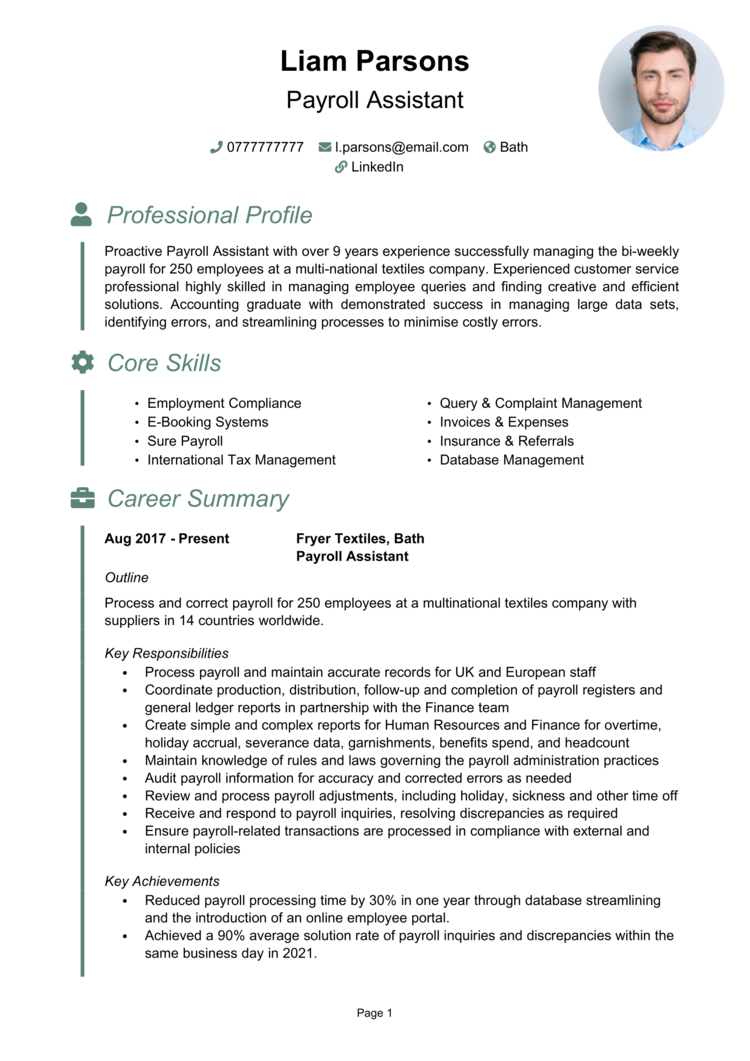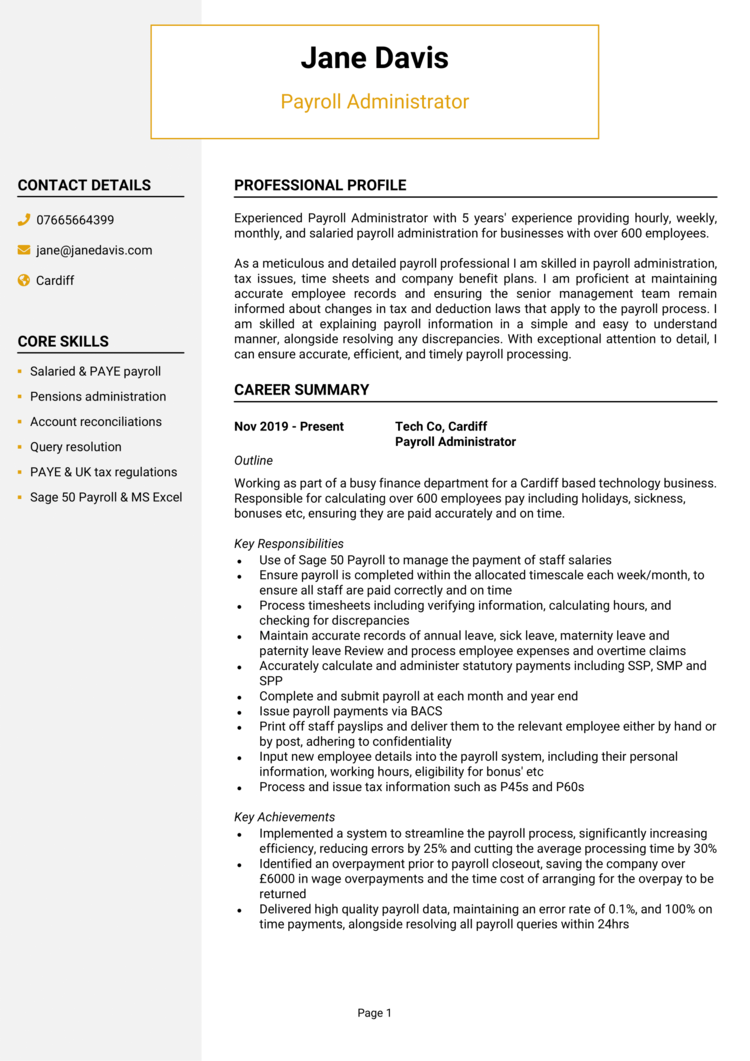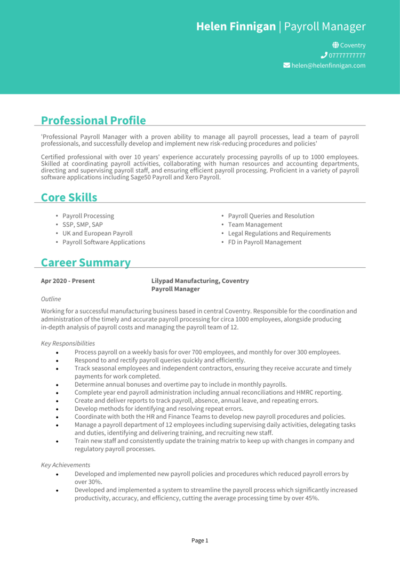Have you got what it takes to make sure every member of a company gets paid accurately and on time, while staying compliant with mountains of complex regulation?
If so, you’re just the payroll manager that every firm needs: but you won’t make it that far without a high-quality CV.
This guide, complete with some incredibly helpful tips and 3 Payroll Manager CV examples, will walk you through how to create a CV that highlights your expertise and gets you hired.
Payroll Manager CV

Payroll Assistant CV

Payroll Administrator CV

How to write your Payroll Manager CV
Learn how to create your own interview-winning Payroll Manager CV with this simple step-by-step guide.
This guide will show you how to write a Payroll Manager CV that’s polished and tailored to the role. From structuring and formatting to showing off your skills in payroll systems and compliance, you’ll learn how to stand out to recruiters and secure your next role.
Payroll Manager CV structure


If you want your CV to showcase your skills and expertise, it’ll need to be as organised and precise as a payroll run. With a clear structure, recruiters can quickly spot why you’re the right fit for the role.
Not sure where to start? Let’s break it down: here’s how you should be structuring your CV:
- Name and contact details – Place these at the top so those impressed recruiters can get in touch right away. A photo is optional but not necessary.
- CV profile – Craft a short introduction that showcases your professional background and key accomplishments which will contribute to a leadership role.
- Core skills – Provide a quick overview of your top skills that’ll demonstrate the value you’ll bring and which show why you’re a great fit.
- Work experience – Outline your career progression in reverse order, emphasising your contributions and successes.
- Education – Mention your degrees, certifications, and any training that supports your career path in the finance industry.
- Additional info – It’s usually a good idea to mention your interests or memberships in professional organisations, like the Chartered Institute of Payroll Professionals (CIPP).
How to format your Payroll Manager CV


If you’re only focusing on the content but not the appearance of your CV, your efforts and stellar qualifications will go to waste.
A clean and readable CV will make sure recruiters can quickly and easily find the relevant information they’re looking for – don’t make checking over your application harder than it needs to be.
Following these design tips will ensure a recruiter appreciates your CV more than the competition:
- Bullet points – Use them to break down tasks and achievements into easy-to-scan chunks.
- Divide sections – Use clear headings to separate key areas like experience and education.
- Use a clear font – Use a simple, professional font and keep your layout uncluttered for maximum readability.
- No more than 2 pages – This gives you enough space to showcase your expertise without losing the recruiter’s interest.
Payroll Manager CV profile


Your profile is the opening section of your CV. As you’d expect, it needs to grab the recruiter’s attention right away. For a Payroll Manager, this is where you highlight your ability to manage payroll operations, ensure flawless compliance with regulations, and lead a team.
Payroll Manager CV profile examples
Profile 1
Experienced Payroll Manager with eight years in the manufacturing industry, overseeing payroll operations for 500+ employees. Proficient in Sage and Xero, with a strong track record of ensuring compliance, improving efficiency, and delivering accurate reporting to senior leadership.
Profile 2
Reliable Payroll Manager with six years in the retail sector, managing payroll for large, multi-site teams. Skilled in handling statutory deductions, RTI submissions, and resolving payroll discrepancies. Adept at leading system migrations and training staff in payroll processes.
Profile 3
Dedicated Payroll Manager with over a decade of experience in financial services, specialising in payroll for high-net-worth individuals and small teams. Expertise in payroll reconciliations, implementing GDPR-compliant practices, and advising management on pay structures. Proficient in ADP and bespoke payroll systems.
What to include in your Payroll Manager CV profile
Tailor your profile to the job description, reflecting the skills and experience the employer values most.
Here’s what to include in your Payroll Manager CV profile:
- Where you’ve worked – Mention the types of organisations you’ve managed payroll for, like SMEs, corporations, or in the public sector.
- Your top qualifications – Highlight certifications such as CIPP or accounting credentials.
- Essential skills – Focus on payroll system proficiency, compliance expertise, and team leadership.
- People you’ve worked with – Include collaboration with HR, finance teams, or external auditors.
- Types of payroll you’ve managed – Add specific examples, such as multi-country payrolls, complex benefits schemes, or contractor payments.
- Relevant tools you know – Mention software expertise, like Sage, ADP, or SAP payroll modules.
How to highlight your core skills


Think of the core skills section as your CV’s list of “must-haves”. iIt’s where recruiters will get an instant overview of your payroll expertise. For a Payroll Manager, these might include technical abilities like payroll system proficiency or compliance knowledge.
Tailor this section to match the role by emphasising the skills most relevant to the employer. For instance, highlight global payroll management for an international company or advanced tax reporting for a compliance-heavy industry.
Focus on specific skills like “expertise in Sage payroll systems” rather than eye-roll-inducing vague descriptions like “passionate hard worker”. This clarity shows your capabilities at a glance.
The top skills to highlight in your Payroll Manager CV
- Payroll Processing – Managing accurate payrolls for employees across multiple regions or departments.
- Compliance Management – Ensuring payroll adheres to HMRC regulations and GDPR requirements.
- Team Leadership – Leading payroll teams to achieve deadlines and maintain accuracy under pressure.
- System Implementation – Overseeing payroll system upgrades or migrations to improve efficiency.
- Data Integrity – Conducting audits to ensure payroll data accuracy and prevent discrepancies.
- Tax Reporting – Preparing and submitting PAYE, NI, and year-end filings with accuracy.
- Global Payroll Management – Handling international payroll operations, including multi-currency payments.
- Employee Relations – Responding to payroll queries and resolving issues promptly to maintain employee satisfaction.
Work experience


With the reader now fully hooked, it’s time to get into the bulk of your application. Recruiters want someone who has actively contributed to organisational efficiency in their past roles: your work experience section will demonstrate where you’ve been putting your expertise into practice.
List your roles in reverse chronological order, focusing on responsibilities and achievements that highlight your impact.
How to structure jobs

- Outline – Provide an overview of the company, how your role fits into the overall picture, and the scale of your responsibilities.
- Responsibilities – Detail your main duties, such as payroll processing, compliance, or system implementation. Use action verbs like “managed,” “coordinated”, and “streamlined.”
- Achievements – Highlight measurable outcomes, such as increasing payroll accuracy or reducing processing times. Wherever possible, include some facts and figures.
Example jobs for Payroll Manager
Payroll Manager | Effective Tech Inc
Outline
Managed the payroll process for a mid-sized technology firm, ensuring timely and accurate payments to 300+ employees. Focused on compliance with UK payroll legislation and optimising payroll systems for efficiency.
Responsibilities
- Processed monthly payroll using Sage Payroll for salaried and hourly employees.
- Calculated statutory deductions, including PAYE, NI, and pension contributions.
- Handled payroll-related queries, ensuring prompt and accurate resolutions.
- Coordinated with HR to maintain accurate employee records and manage new hires.
- Prepared payroll reports for senior management to support financial planning.
Achievements
- Implemented an automated payroll system, reducing processing time by 30%.
- Improved payroll accuracy by 15% through enhanced auditing practices.
- Trained 3 HR staff members in payroll compliance and software use.
Payroll Supervisor | Lidl
Outline
Oversaw payroll operations for a large retail company with 1,000+ employees. Ensured compliance with employment law and delivered accurate reporting for internal and external audits.
Responsibilities
- Managed end-to-end payroll processing for a multi-site organisation.
- Conducted payroll reconciliations and resolved discrepancies proactively.
- Ensured compliance with HMRC regulations, including RTI submissions.
- Processed overtime payments and bonuses, verifying accuracy against approvals.
- Maintained and updated payroll policies in collaboration with HR and Finance teams.
Achievements
- Reduced payroll errors by 20% through the introduction of a pre-processing checklist.
- Delivered £50,000 in annual cost savings by renegotiating payroll software contracts.
- Successfully led the migration to a new payroll system with no disruption to operations.
Senior Payroll Administrator | Henderson Manufacturing Ltd
Outline
Led payroll functions for a fast-growing manufacturing firm, managing payments for 500 employees across various shifts and pay structures. Provided strategic support to HR and Finance teams.
Responsibilities
- Administered payroll using Xero, ensuring compliance with statutory requirements.
- Monitored and processed sick pay, maternity pay, and other statutory benefits.
- Managed payroll data integrity and confidentiality in line with GDPR standards.
- Prepared monthly and year-end payroll reconciliations for financial audits.
- Advised management on payroll implications of workforce changes and overtime policies.
Achievements
- Reduced payroll processing time by 40% through workflow optimisation.
- Achieved 100% compliance in external payroll audits over three consecutive years.
- Designed a payroll FAQ resource, reducing employee queries by 25%.
What’s the best way to write an education section?


The education section demonstrates the qualifications that underpin your payroll expertise. Include degrees, certifications, and any past training relevant to payroll or finance.
If you’re newer to the role, highlight modules or projects that align with the sort of skills you’d be expected to have on the job. For experienced candidates, keep this section concise, as a recruiter will simply care more about your experience.
Once again, list your qualifications in reverse chronological order, starting with the most recent.
Key qualifications for a Payroll Manager
- Chartered Institute of Payroll Professionals (CIPP) Qualification
- Diploma in Payroll Management
- AAT Accounting Qualification
- Bachelor’s Degree in Accounting or Finance
- Sage 50 Payroll Certification





